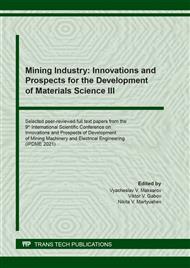[1]
S.F. Golovashchenko, N. Wang, Q. Le, Trimming and Sheared Edge Stretchability of Automotive 6xxx Aluminum Alloys, Journal of Materials Processing Technology 264 (2019) 64.
DOI: 10.1016/j.jmatprotec.2018.09.001
Google Scholar
[2]
M. Abdala, J.C. Garcia-de-Blas, C. Barbosa, O. Acselrad, Acselrad, Thermoelectrical power analysis of precipitation in 6013 aluminum alloy, Materials Characterization 59 (2008) 271-277.
DOI: 10.1016/j.matchar.2007.01.005
Google Scholar
[3]
K.B.S. Couto, S.R. Claves, W.H. Van Geertruyden, W.Z. Misiolek, M. Goncalves, Effects of homogenisation treatment on microstructure and hot ductility of aluminium alloy 6063, Materials Science and Technology 21 (2005),, 263-268.
DOI: 10.1179/174328405x18584
Google Scholar
[4]
R.S. Mishra, Z.Y. Ma, Friction stir welding and processing, Materials Science and Engineering: R: Reports 50 (2005) 1-78.
Google Scholar
[5]
A.V. Egorov, V.V. Polyakov, D.S. Salita, E.A. Kolubaev, Inspection of aluminum alloys by a multi-frequency eddy current method, Defence Technology 11(2) (2015) 99–103.
DOI: 10.1016/j.dt.2014.12.002
Google Scholar
[6]
C.Y. Liu, B. Qu, P. Xue, Fabrication of large-bulk ultrafine grained 6061 aluminum alloy by rolling and low-heat-input friction stir welding. Journal of Materials Science & Technology 34 (2018) 112–118.
DOI: 10.1016/j.jmst.2017.02.008
Google Scholar
[7]
C. Yang, J. F. Zhang, G. N. Ma, L. H. Wu, Microstructure and mechanical properties of double-side friction stir welded 6082 Al ultra-thick plates, Journal of Materials Science & Technology 41 (2020) 105–116.
DOI: 10.1016/j.jmst.2019.10.005
Google Scholar
[8]
P. Dong, D. Q. Sun, Natural aging behaviour of friction stir welded 6005A-T6 aluminium alloy, Materials Science and Engineering: A 576 (2013) 29–35.
DOI: 10.1016/j.msea.2013.03.077
Google Scholar
[9]
I. Vysotskiy, S. Malopheyev, S. Mironov, R. Kaibyshev, Effect of pre-strain path on suppression of abnormal grain growth in friction stir welded 6061 aluminum alloy, Materials Science and Engineering: A 760 (2019) 206–213.
DOI: 10.1016/j.msea.2019.05.118
Google Scholar
[10]
W.M. Thomas, E.D. Nicholas, J.C. Needham, M.G. Murch, Friction welding, U.S. Patent 5 (1995) 460-317.
Google Scholar
[11]
S. Chen, X. Li, X. Jiang, T. Yuan, Y. Hu, The effect of microstructure on the mechanical properties of friction stir welded 5A06 Al Alloy, Materials Science and Engineering: A 735 (2018) 382-393.
DOI: 10.1016/j.msea.2018.08.020
Google Scholar
[12]
F. Panzer, M. Werz, S. Weihe, 'Experimental investigation of the friction stir welding dynamics of 6000 series aluminum alloys, Production Engineering 12 (2018) 667-677.
DOI: 10.1007/s11740-018-0834-z
Google Scholar
[13]
J. Rasti, Int. J. Adv. Manuf. Tech. 2018, 97, 2221.
Google Scholar
[14]
M. Imam, V. Racherla, K. Biswas, H. Fujii, V. Chintapenta, Y.F. Sun, Y. Morisada, Microstructure-property relation and evolution in friction stir welding of naturally aged 6063 aluminium alloy, The International Journal of Advanced Manufacturing Technology 91 (2017) 5-8.
DOI: 10.1007/s00170-016-9865-9
Google Scholar
[15]
V.A. Bakshaev, P.A. Vasilev, Friction stir welding in manufacturing of large-sized aluminum alloy products, Tsvetnye Metally (Non-ferrous metals) 1 (2014) 14–18.
Google Scholar
[16]
V.E. Rubtsov, E.A. Kolubaev, S.Yu. Tarasov, Thermography Inspection of Friction Stir Welding, AIP Conference Proceedings 1623 (2014) 535–538.
DOI: 10.1063/1.4899000
Google Scholar
[17]
C. Mandache, L. Dubourg, A. Merati, M. Jahazi, Pulsed eddy current testing of friction stir welds, Materials Evaluation 66(4) (2008) 382–386.
Google Scholar
[18]
M. Moles, A. Lamarre, O. Dupuis, Complete inspection of friction stir welds in Aluminum using ultrasonic and Eddy currents arrays, Proceedings - 16th WCNDT 2004 – World Conference on NDT (Montreal, Canada, 2004) p.87–92.
Google Scholar
[19]
P.H. Johnston, Addressing the limit of detectability of residual oxide discontinuities in friction stir butt welds of aluminum using phased array ultrasound, Proceedings - 35th Annual Review of Progress in Quantitative Nondestructive Evaluation (Chicago, Illinois, 2008) p.1–26.
DOI: 10.1063/1.3114191
Google Scholar
[20]
T.A. Klimova, T.A. Il'inkova, A.I. Shigapov, Non-destructive control of the weakening of profiles made of V95OChT2 aluminum alloy, Metal science and heat treatment of metals 5 (2015) 37–41.
Google Scholar
[21]
D. Grundy, V. Zilberstein, N. Goldfine, MWM®-array inspection for quality control of friction stir welded extrusions, Proceedings - 7th International Conference on Trends in Welding Research (Pine Mountain, Georgia, USA, 2005) p.227–232.
Google Scholar
[22]
T. Santos, P.M. Ramos, P. Vilaça, Nondestructive testing of friction stir welding: comparison of planar eddy current probes, Proceedings - IMEKO TC4 Symposium (Florence, Italy, 2008) p.507–512.
Google Scholar
[23]
L.S. Rosado, T.G. Santos, M. Piedade, P.M. Ramos, P. Vilaca, Advanced technique for non-destructive testing of friction stir welding of metals, Journal of Measurement 43 (2010) 1021-1030.
DOI: 10.1016/j.measurement.2010.02.006
Google Scholar
[24]
B. Li, Y. Shen, W. Hu, The study of defects in aluminium 2219-T6 Thick butt friction stir welds with the application of multiple nondestructive testing methods, Materials and Design 32 (2011) 2073–(2084).
DOI: 10.1016/j.matdes.2010.11.054
Google Scholar
[25]
B. Hu, R. Yu, H. Zou, Magnetic non-destructive testing methods for thin plate aluminium alloys, NDT&E International 47 (2012) 66–69.
DOI: 10.1016/j.ndteint.2011.12.007
Google Scholar
[26]
P. Vilaça, T.G. Santos, L. Rosado, R.M. Miranda, Innovative concept and application of ec probe for inspection of friction stir welds, Proceedings - The 12th International Conference of the Slovenian Society for Non-Destructive Testing Application of Contemporary Non-Destructive Testing in Engineering (Portorož, Slovenia, 2013) pp.329-338.
DOI: 10.1504/ijmmp.2014.066912
Google Scholar
[27]
H. Brauer, J.M. Otterbach, Friction stir weld inspection using the motion induced eddy current testing technique, AIP Conference Proceedings 2102 (2019) 080004.
DOI: 10.1063/1.5099812
Google Scholar
[28]
S.F. Dmitriev, A.V. Ishkov, A.O. Katasonov, Measurement System for Studying Flaws in Alloy Slabs by Means of Subminiature Eddy-Current Transducers, Measurement Techniques 60(4) (2017) 372-375.
DOI: 10.1007/s11018-017-1204-5
Google Scholar
[29]
S.F. Dmitriev, A.V. Ishkov, V.N. Malikov, A.M. Sagalakov, Scanning the Welded Seams of Titanium Alloys by Using Subminiature Eddy Current Transducers, Materials Science Forum 906 (2017) 147-152.
DOI: 10.4028/www.scientific.net/msf.906.147
Google Scholar


